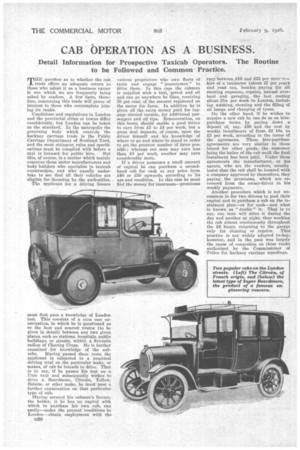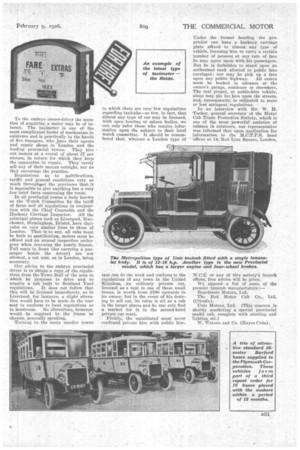CAB OPERATION AS A BUSINESS.
Page 14

Page 15

If you've noticed an error in this article please click here to report it so we can fix it.
Detail Information for Prospective Taxicab Operators. The Routine to be Followed and Common Practice.
T"question as to whether the cab trade offers an adequate return to those who adopt it as a business career is one which we are frequently being asked by readers. A few facts, therefore, concerning this trade will prove of interest to those who contemplate joining its ranks.
Conditions and regulations in London and the provincial cities or towns differ considerably, but London can be taken as the standard. In the metropolis the governing body which controls the hackney carriage trade is the Public Carriage Department of Scotland Yard, and the most stringent rules and specifications must be complied with before a
taxi is licensed for public hire. But this, of course, is a matter which mainly coneerns those Motor manufacturers and body builders who specialize in taxicab construction, 2111(1 who usually undertake to• see that all their vehicles are eligible for licensing by the authorities.
The applicant for a driving licence
must first pass a knowledge of London test. This consists of a viva roes examination, in which he is questioned as to the best and nearest routes (to be given in detail) between any two given places, such as stations, hospitals, public buildings, or streets, within a Ave-mile radius of Charing Cress. He is further examined for knowledge of the sub
urbs. Having passed these tests, the applicant is subjected to a practical driving trial on the particular make, or makes, of cab he intends to drive: That is to say, if he passes his test on a Pi& taxi and subsequently wishes to drive a Beardmore, Citro0.1, Yellow, Belsize, or other make, he must pass a further examination on that particular type of cab.
Having secured his cabman's licence, the holder, if he has no capital with which to purchase his own cab, can easily—under the present conditions in London—obtain employment with the.
D30 various proprietors who own fleets of taxis and engage "journeymen" to drive them. In this case the cabman is supplied with a taxi, petrol suid oil and can go anywhere he likes, receiving 80 per cent. of the amount registered on the meter for fares. In addition he is given all the extra money paid for luggage carded outside, for additional passengers and all tips. Remuneration, on this basis, should enable a good driver to earn from 18 to £4 per week, but a great deal depends, of course, upon the driver himself and his knowledge of where to go and where to stand in order to get the greatest number of fares possible; whereas one man may earn less than Lii per week, another may earn considerably more.
If a driver. possesses a small amount of capital be can purchase a secondhand cab for cash at any price from £40 or £50 upwards, according to its age and condition. In this ease he must find the money for insurance—premiums
vary between £16 and £22 per aimr•nhire of a taximeter (about ET per year)! and road tax, besides paying for all running expenses, -repairs, annual over-, halal and garaging, the last costing about 21:s. per Week in London, including washing, cleaning and the filling of oil lamps and changing of tyres.
On the other hand, if he wishes to acquire a new cab he can do so on hirepurchase terms by paying down a,. deposit of, say, £50 and the rest by. weekly instalinents of from £2 10s. to 13 per week, according to the terms of the agreement, These hire-purchase agreements are very similar to those issued for other goods, the customer being the bailee of the cab until the final instalment hag been paid. Under these agreements the manufacturer, or his agents, who are the vendors, usually insist that the cab shall be insured with a company approved by themselves, they paying the " premiums, which are •recovered from the owner-driver in his weekly payments.
Another procedure which is not uncommon is for two drivers to pool their capital and to purchase a cab on the instalment plan—or for cash—and what is known as "double" it. That is to say, one man will drive it during the day and another at night, thus working the cab almost continuously throughout the 24 hours, returning to the garage
only for cleaning or repairs. Thig. practice is not widely adopted to-day, however, and in the past was largely the cause of congestion on those ranks authorized by the Commissioner of. Police for hackney carriage standings.
To the embryo owner-driver the question of acquiring a meter may be of interest. The taximeter is one of the most complicated forms of mechanism in existence and is practically in the hands of five -concerns, who have their agents and repair shops in 'London and the leading provincial towns. They hire out meters at a rental of about /7 per annum, in return for which they keep the apparatus in repair. They rarely sell any of their meters outright, nor do they encourage the practice.
Regulations as to specifications, tariffs and general conditions vary so muCh throug,hgat the provinces that it is impossible to give anything but a very few brief facts concerning the trade.
In all provincial towns a body known as the Watch Committee fix the tariff of fares and all regulations in conjunction with the Chief Constable and the Hackney Carriage Inspector. All the principal places sueh as Liverpool, Manchester, Birmingham, Bristol, have their rules on very similar lines to those of London. That is to say, all cabs must be built to specification, meters must be affixed and an annual inspection undergone when renewing the yearly licence. Pull seats in front (for carrying a passenger beside the driver) are not allowed, a cut seat, as in London, being necessary.
Our advice to the embryo provincial driver is to Obtain a copy of the regulations from the Town Hail of the area in which he proposes to drive and to acquire a cab built to Scotland Yard regulations. It does not follow that this will be licensed immediately, as in Liverpool; for instance, a slight alteration would have to be made in the rear seat to conform to local -regulations as to headroom. No alterations, however, would be required in the frame or chassis, generally speaking.
Turning to the many smaller towns
in which there are very few regulations regarding taxicabs—so few, in fact, that almost any type of car may be licensed, with open touring or saloon bodies, we can only refer those who require information upon the subject to their local watch committee. It should be remembered that, whereas a London type of
taxi can do the work and conform to the regulations of any town in the United Kingdom, an ordinaryprivate ear, licensed as a taxi in one of these small towns, is worth from 1100 upwards to its owner, but in the event of his desiring to sell out, its value is nil as a cab in the larger places and he can only find a market for it in the second-hand private car mart.
Finally, the uninitiated must never confound private hire with public hire. Under the former heading the proprietor can have a hackney carriage plate affixed to Almost any type of vehicle, licensing him to carry a certain number of persons at any rate of fare he may agree upon with his passengers, But he is forbidden to stand upon an authorized rank allotted to public hire carriages ; nor may he pick up a fare • upon any public highway. All orders must be booked in advance at the owner's garage, residence or elsewhere. The taxi proper, or public-hire vehicle, alone may ply for hire upon the streets, and, consequently,' is subjected to more or less stringent regulations.
In an interview with Mr. W. H. Tucker, general secretary of the Motor Cab Trade Protection Society, which is one of the most powerful societies of cabmen in existence, our representative was informed that upon application for information to the M.C.T.P.S. head Offices at 14, Red Lion Square, London,
or any of this society's branch offiCeS, free advice will be given.• We append a list of some of the premier taxicab manufacturers:— Beardmore Motors, Ltd: The Red Motor Cab Co., Ltd.
(Citroen). • Unic Motors, Ltd. (This concern is shortly marketing a special provincial model cab, complete with starting and lighting set.) W. Watson and Co. (Hayes Cabs).


























































